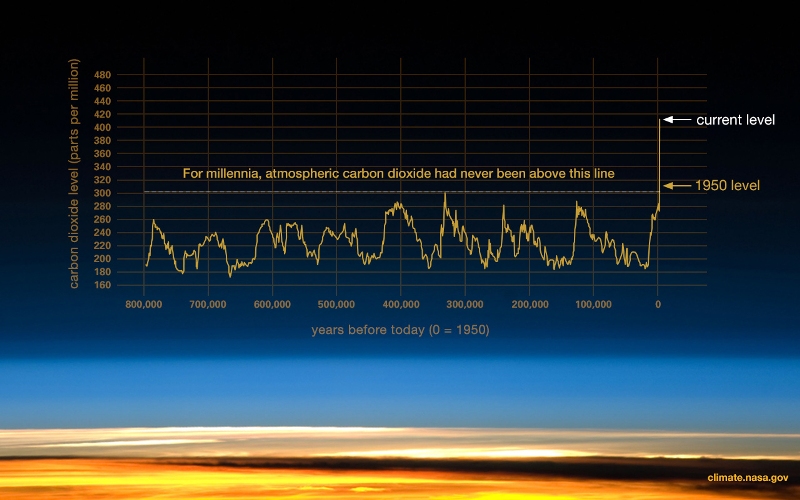File:NASA co2-graph-061219.jpg
NASA_co2-graph-061219.jpg (800 × 500 pixels, file size: 214 KB, MIME type: image/jpeg)
Evidence / Facts
Climate Change: How Do We Know?
• https://climate.nasa.gov/evidence/
The Earth's climate has changed throughout history. Just in the last 650,000 years there have been seven cycles of glacial advance and retreat, with the abrupt end of the last ice age about 7,000 years ago marking the beginning of the modern climate era — and of human civilization. Most of these climate changes are attributed to very small variations in Earth’s orbit that change the amount of solar energy our planet receives.
Scientific evidence for warming of the climate system is unequivocal
- Intergovernmental Panel on Climate Change
The current warming trend is of particular significance because most of it is extremely likely (greater than 95 percent probability) to be the result of human activity since the mid-20th century and proceeding at a rate that is unprecedented over decades to millennia.
Earth-orbiting satellites and other technological advances have enabled scientists to see the big picture, collecting many different types of information about our planet and its climate on a global scale. This body of data, collected over many years, reveals the signals of a changing climate.
The heat-trapping nature of carbon dioxide and other gases was demonstrated in the mid-19th century. Their ability to affect the transfer of infrared energy through the atmosphere is the scientific basis of many instruments flown by NASA. There is no question that increased levels of greenhouse gases must cause the Earth to warm in response.
Ice cores drawn from Greenland, Antarctica, and tropical mountain glaciers show that the Earth’s climate responds to changes in greenhouse gas levels. Ancient evidence can also be found in tree rings, ocean sediments, coral reefs, and layers of sedimentary rocks. This ancient, or paleoclimate, evidence reveals that current warming is occurring roughly ten times faster than the average rate of ice-age-recovery warming.
○
File history
Click on a date/time to view the file as it appeared at that time.
| Date/Time | Thumbnail | Dimensions | User | Comment | |
|---|---|---|---|---|---|
| current | 20:18, 24 June 2019 |  | 800 × 500 (214 KB) | Siterunner (talk | contribs) |
You cannot overwrite this file.
File usage
The following 9 pages use this file:
- Climate News Events Archive ... 1970 to Today
- Earth Science Vital Signs
- Environmental full-cost accounting
- Life and the 'Human Niche' at Risk
- Too Hot
- File:Changes in carbon dioxide per 1000 years - via Climate Central.jpg
- File:Earth in Human Hands.jpg
- File:Earth trapping unprecedented amount of heat - NASA.jpg
- File:Temperatures New Normal is Not Normal.jpg
- Additional Website Resources - Linked Data - Green Best Practices
- Antarctica
- Anthropocene
- Arctic
- Atmospheric Science
- Biodiversity
- Climate Change
- Climate Policy
- Earth360
- Earth Law
- Earth Observations
- Earth Imaging
- Earth Science
- Earth Science from Space
- Earth System Science
- Eco-nomics
- Ecology Studies
- Environmental Full-cost Accounting
- Environmental Protection
- Environmental Security
- Environmental Security, National Security
- EOS eco Operating System
- ESA
- Externalities
- Global Security
- Green Graphics
- Health
- ISS
- Land Ethic
- New Space
- Oceans
- Ocean Ecosystem
- Ocean Science
- Ocean Sustainability
- Planet Citizen
- Planet Citizens
- Planet Scientist
- Planet Citizens, Planet Scientists
- Sea-level Rise
- Solar Energy
- Strategic Demands
- Sustainability
- Sustainability Policies
- ThinBlueLayer
- Virtual Planet
- Biogeosciences
- Cryosphere
- Geophysics and Geochemistry
- Mineralogy
- Geology
- Geophysics
- Hydrology
- Natural Resources
- Planetary Science
- United Nations
- United Nations Framework Convention on Climate Change
- US Environmental Protection Agency
